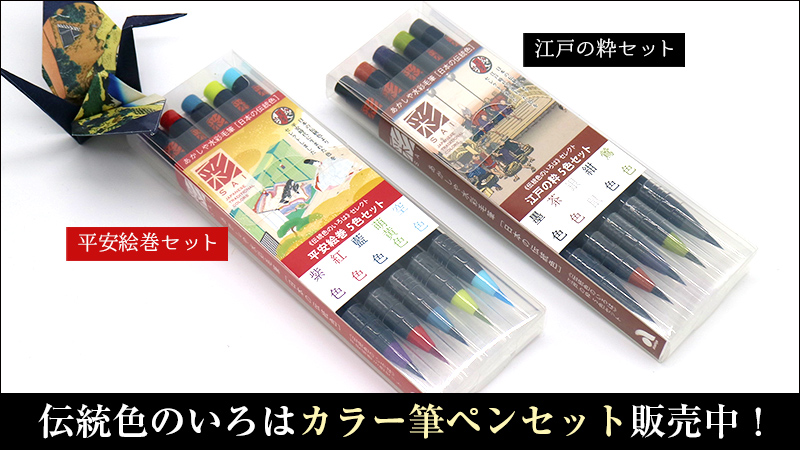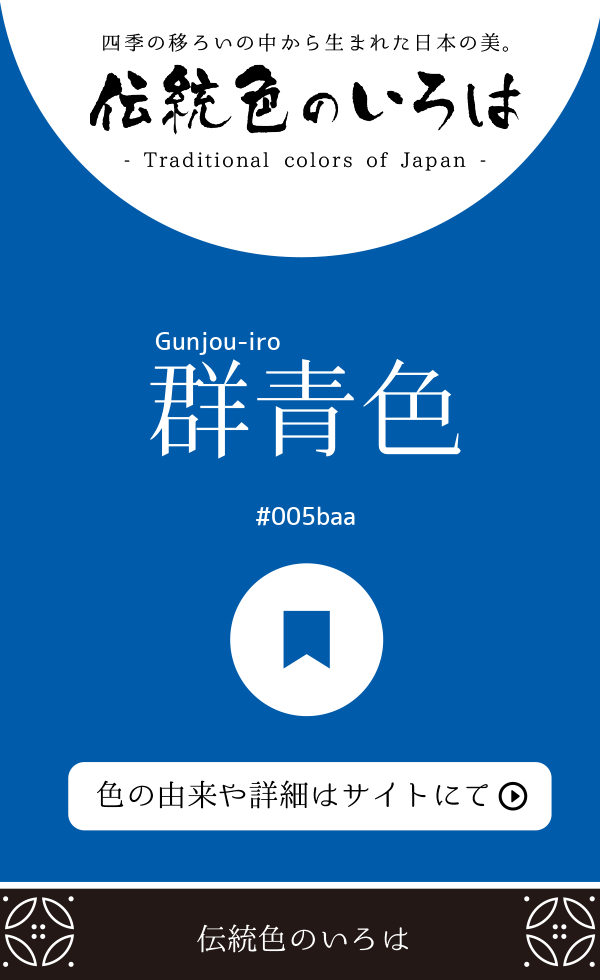7月9日の誕辰和色
占い結果
日本語版| 特徴1 | 特徴2 | インスピレーションワード |
|---|---|---|
| バランス感覚がある | 博識 | クラッシック音楽 |
| Characteristic 1 | Characteristic 2 | Inspiration Words |
|---|---|---|
| I have a sense of balance. | wide knowledge | classical music |
| 特征1 | 特征2 | 鼓舞人心的话语 |
|---|---|---|
| 我有一种平衡感。 | 博闻强记 | 古典音乐 |
【インスピレーションワードとは】あなたの直感の元となるワード、閃き、発想が刺激されるワードです。(宣託師:白龍恵子)
誕生日の色が知りたい方は⇒「誕辰和色」へ

色の説明
群青色(ぐんじょういろ)とは、日本画材の岩絵具 の『群青 』に由来する色名で、紫みがかった深い青色のことです。日本画には欠かせない色であり、桃山時代の障壁画、江戸時代の琳派 の屏風絵 などに使われています。
岩絵具の「群青」は、もとは鉱物の瑠璃 (ラピスラズリ)から作られたものでしたが、瑠璃は宝石としても非常に高価なため、藍銅鉱 (アズライト)を原料とするようになっていきます。ただ、どちらにしても高価な鉱物を砕いて作られているため、群青の色は人工の岩絵具が登場するまで、宝石に匹敵するほど貴重な『青』でした。
天然の岩絵具は、同じ原料でも鉱物の粒子が細かくなるほど色は淡 くなり、粒が荒いほうから『紺青 』、『群青』、そして最も粒が細かい色を『白群 』と呼びます。
ちなみに、砕いた鉱物、青の粒の集まりということから「青が群れ集まる」という意味の『群青』という色名になったようです。
藍銅鉱(らんどうこう)
藍銅鉱は鉱物(炭酸塩鉱物)の一種。英名では、「アズライト(azurite)」。
結晶系は単斜晶系。「ブルー・マラカイト」と呼ばれる宝石でもあります。
藍銅鉱は銅の代表的な二次鉱物の1つで、世界各地の銅鉱床の風化帯にて産します。ちなみに、同じ銅の二次鉱物である孔雀石 (マラカイト)も共生することが多いです。
『群青』がいつ頃から使われるようになったか定かではありませんが、江戸中期の画法書「画筌 」に「紺青…これを摺 って群青を出す」との説明が見られることから、江戸期には一般化していたようです。ただ、染色名には用いられていません。
また、この記述から『群青』が『紺青』の淡色 であったことが分かります。
また、古代では『紺青』より淡い青は、すべて『白青 』と呼ばれていました。
岩絵の具の「群青」は、原料である藍銅鉱が孔雀石と混じって採れることが多いため、精製が難しく、孔雀石からとれる岩絵具の「緑青 」の10倍の値段で取引され、群青60gで米一俵買えるほどでした。
こんにちでも人工岩絵具の群青の色相は、「紫み」「深青」「緑み」の三系統があり、色味に幅があります。これは、藍銅鉱を砕いて作られた「岩群青」、瑠璃を砕いて作られた古い「群青」、そして緑系の孔雀石が混じった藍銅鉱から作られた「岩群青」に由来しているためでしょう。なお、今回は天然群青の標準的な色調を使用しています。
高価で貴重な青『群青』が使われるのは、日本画の中でも如来像や菩薩像の頭髪、曼荼羅の一部など、尊いものが主でした。 当時の絵師はきっと『群青』の青に強烈に憧れたことでしょう。だからこそ、『群青色』は現代にも消えずに残っているのかもしれません。

-読み:ぐんじょういろ-
「丁度十月も末の事で、菊日和の暖かさが続く、空は群青色に澄み渡るなかへ」
『錦木』柳川春葉著。明治三四年(一九◯一)
関連する色の紹介
[Explanation of a color]
The Gunjo-iro is a color name derived from rock paint "Gunjo" of Japanese painting materials, which is purplish deep blue color. It is an indispensable color for Japanese painting, it is used for the barrier paintings of the Momoyama period and the Rinpa painting picture of the Edo period.
The rock paint "Gunjo" was originally made from mineral lapis lazuli, but since the lapis is also very expensive as a gemstone, it will become a raw material of asurite. However, because it is made by crushing expensive minerals either way, the color of Gunjo was precious "blue" comparable to jewelry until artificial rock paint appeared.
Natural rock paint, even with the same raw material, the color becomes faint as the mineral particles become finer, the "Konjo", "Gunjo", and the finest grain are called "Bhakugun" from the rough one.
By the way, it seems that it became the color name "Gunjo" meaning "blue gathers together" because it is a crushed mineral, a collection of blue grains.
Azurite
Azurite is a kind of mineral (carbonate mineral).
The crystal system is monoclinic system. It is also a gem called "Blue Malachite".
Cyanide ore is one of the representative secondary minerals of copper and it is produced in weathered zones of copper deposits around the world. By the way, malachite, which is the secondary mineral of copper, also coexists in many cases.
Although it is not certain when "Guinjo" came to be used from around, it can be seen from the explanation that "Konjo ... putting out Gunjo by doing this" in the middle-Edo Editorial Picture Book "Gakei", Edo period It seems that it was generalized to. However, it is not used as a staining name. Also, from this description, you can see that Gunjo was a light color of "Konjo".
Also, in ancient times, all the pale blue from "Konjo" was called "Shiroao".
The rock paint "Gunjo" is often traded at the price of 10 times the rock paint "Ryokusho" which is difficult to refine and can be taken from malachite, because it is often the case that the raw blue copper ore can be mixed with malachite, 60 g ultramarine blue It was enough to buy one rice of rice.
Hint of artificial rock paint The color of ultramarine blue has three lines of "purple", "deep blue" and "greenish", and there is a range in color. It is derived from "Iwagunjo" made by crushing cyanide ore, old "Gunjo" made by crushing lapis, and "Iwagunjo" made from indigo copper mingled with green-based peacocks Because. In addition, this time we use the standard color tones of natural Gunjo.
The expensive and valuable blue "Gunjo" is used mainly in precious things such as Takara image, Bodhisattva head hair, part of mandala among Japanese paintings. The painter at that time probably was longing for the blue of "Gunjo" intensely. That is why "Gunjo-iro" may remain in the present age.
-read: Gunjou-iro-
参考書籍
- 長崎盛輝『新版 日本の伝統色 その色名と色調』青幻舎 ISBN-10:4861520711
- 吉岡幸雄『日本の色辞典』紫紅社 ISBN-10:4879405493
- 内田 広由紀『定本 和の色事典』視覚デザイン研究所 ISBN-10:4881082035
注意事項
表示されている色(RGB値)は色の名前に対するおおよそものです。色名によっては広範囲の色を指す場合や文献・書籍等によっては解釈が異なる場合もありますのでご了承ください。 ご利用の環境によっては、色が適切に表示されていない場合があります。
印刷などに伝統色を利用したい場合は、DICグラフィックス株式会社から発売されている日本の伝統色シリーズがオススメです。
Pinterestでシェアする際にご利用ください。
サイト運営者からのお願い
このサイトが気に入った、役に立ったと思われた方は、Amazon・楽天で買い物をする際はぜひ下記のバナーをタップしてからお買い物をお願いいたします。
こちらからお買い物をしていただきますと、価格の1%相当のポイントがサイトに入ります。もちろんその分、高くなるようなことはありません。
いただいたポイントは今後のサイト運営のための書籍代や運営費、モチベーションにつながりますので、ご協力いただけますと嬉しいです。

 DIC 日本の伝統色 第9版
DIC 日本の伝統色 第9版



